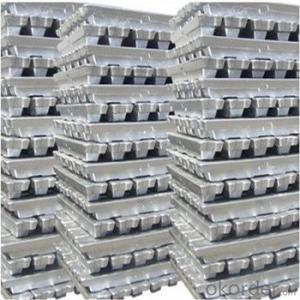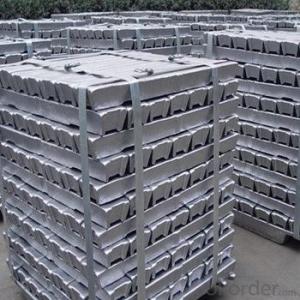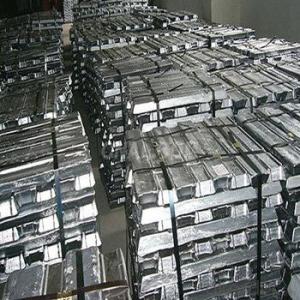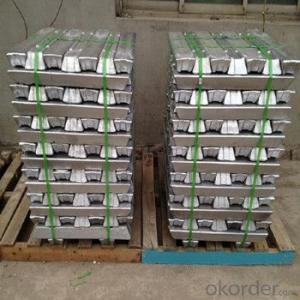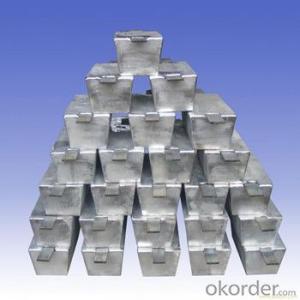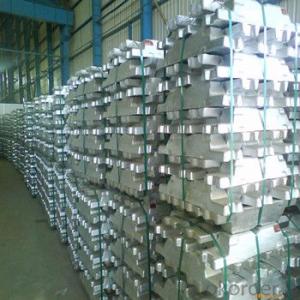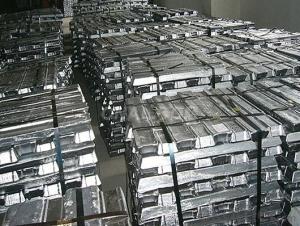Aluminum Pig/Ingot Best Seller 201 From China
- Loading Port:
- China main port
- Payment Terms:
- TT OR LC
- Min Order Qty:
- 1000 m.t.
- Supply Capability:
- 100000 m.t./month
OKorder Service Pledge
OKorder Financial Service
You Might Also Like
Pure Aluminum Pig/Ingot Used for Industry
1.Structure of Aluminum Pig/Ingot
A material that has been cast into a shape in order to be transported and processed easier than in an unprocessed form. An ingot is typically rectangular in shape, which allows it to be stacked. Ingots are most commonly associated with metals, with ingots of gold held in the vaults of banks and brokerages being popular images.
Aluminum Ingot is with the AL as the main chemical composition.Aluminum Ingot is used for industry,such as automobile,pinning and weaving,electron broadly and so on. Aluminum Ingot has the following advantages: easy control and operation, fast melting.
2.Main Features of the Aluminum Pig/Ingot
•High Purity
•Easy control and operation
•High strength
•Fast melting
•Competitive price
•Best Service
3.Aluminum Pig/Ingot Images
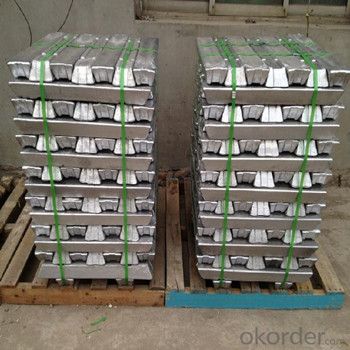

4.Aluminum Pig/Ingot Specification
Grade | Chemical Composition % | |||||||||
Al≥ | impurities ≤ | |||||||||
Si | Fe | Cu | Ga | Mg | Zn | Mn | others | Sum | ||
Al99.9 | 99.90 | 0.50 | 0.07 | 0.005 | 0.02 | 0.01 | 0.025 | - | 0.010 | 0.10 |
Al99.85 | 99.85 | 0.80 | 0.12 | 0.005 | 0.03 | 0.02 | 0.030 | - | 0.015 | 0.15 |
Al99.7 | 99.70 | 0.10 | 0.20 | 0.010 | 0.03 | 0.02 | 0.030 | - | 0.030 | 0.30 |
Al99.6 | 99.60 | 0.16 | 0.25 | 0.010 | 0.03 | 0.03 | 0.030 | - | 0.030 | 0.40 |
Al99.5 | 99.50 | 0.22 | 0.30 | 0.020 | 0.03 | 0.05 | 0.050 | - | 0.030 | 0.50 |
Al99.00 | 99.00 | 0.42 | 0.50 | 0.020 | 0.03 | 0.05 | 0.050 | - | 0.050 | 1.00 |
5.FAQ of Aluminum Pig/Ingot
We have organized several common questions for our clients,may help you sincerely:
①How about your company?
A professional manufacturers of the alumiun pig.Devoted in this industry for many years,so got much experice.The quality and service have also accepted by customer.Can meet customers' requiements to provide different grade and purity alumiun pig.
②How to guarantee the quality of the products?
We have established the international advanced quality management system,every link from raw material to final product we have strict quality test;We resolutely put an end to unqualified products flowing into the market. At the same time, we will provide necessary follow-up service assurance.
③How long can we receive the prod rking days, We will arrange the factory delivery as soon as possible. The pecific time of receiving is related to the state and position of customers.Commonly 7 to 10 working days can be served.
- Q:How is aluminium ingot produced?
- There are mainly three types of bauxite for the production of alumina: gibbsite, diaspore and diaspore. In the world has proven reserves of bauxite, 92% is weathering lateritic bauxite, belonging to gibbsite type bauxite. The characteristics of these is low silicon, high iron and high silicon aluminum ratio, concentrated in West Africa, Oceania and central and South america. The remaining 8% are sedimentary type bauxite, belong to diaspore and diaspore type, low grade, mainly in Greece, the former Yugoslavia and Hungary and other places. Because of the different characteristics of the three kinds of bauxite, different production processes have been adopted in the alumina production enterprises. At present, there are three kinds of Bayer process, the alkali lime sintering method and the Bayer sintering combined method. High grade bauxite is usually produced by Bayer process, and medium or low grade bauxite is produced by combined method or sintering method. Because of its simple process and low energy consumption, Bayer process has become the most important method in the production of alumina at present, and the output is about 95% of the total alumina production.
- Q:How is the purity of an aluminum ingot determined?
- The purity of an aluminum ingot is determined through various analytical techniques such as atomic absorption spectroscopy, inductively coupled plasma mass spectrometry, or X-ray fluorescence spectroscopy. These methods analyze the concentration of impurities, such as iron, copper, zinc, silicon, and magnesium, present in the ingot. The lower the concentration of impurities, the higher the purity of the aluminum ingot.
- Q:What are the environmental benefits of using aluminum ingots?
- Using aluminum ingots offers several environmental benefits. Firstly, aluminum is a highly recyclable material, meaning that it can be melted down and reused repeatedly without any loss in quality. This recycling process consumes significantly less energy and produces fewer greenhouse gas emissions compared to the production of primary aluminum from raw materials. Secondly, aluminum ingots are lightweight, making them an ideal choice for transportation and packaging. Their low weight reduces fuel consumption, leading to lower carbon emissions. Lastly, using aluminum ingots helps to reduce the reliance on mining for raw materials, which can lead to habitat destruction and other negative environmental impacts.
- Q:How much is the power consumption to smelt a ton of aluminium ingot?
- Theoretically, 1 tons of aluminium ingots are melted down, consuming 500 degrees
- Q:What are the different recycling methods for aluminum ingots?
- There are several recycling methods for aluminum ingots, including mechanical recycling, which involves melting the ingots and then casting them into new shapes; chemical recycling, where the ingots are dissolved in a chemical solution to separate impurities and recover pure aluminum; and electrolytic recycling, which uses an electric current to separate aluminum from other metals in the ingots. These methods help to minimize waste and conserve resources by allowing aluminum to be reused and repurposed.
- Q:What are the advantages of using recycled aluminum ingots?
- There are several advantages of using recycled aluminum ingots. Firstly, recycling aluminum saves energy as it requires significantly less energy to produce recycled aluminum compared to virgin aluminum. This helps in reducing greenhouse gas emissions and mitigating climate change. Secondly, using recycled aluminum ingots reduces the need for mining and extraction of bauxite, the primary raw material for aluminum production, thereby conserving natural resources. Additionally, recycling aluminum helps in reducing landfill waste and promotes a circular economy by reusing materials instead of disposing them. Lastly, recycled aluminum ingots exhibit the same quality and performance as virgin aluminum, making them a sustainable and cost-effective alternative for various industries.
- Q:How are aluminum ingots protected from corrosion?
- There are several methods available to protect aluminum ingots from corrosion. One of these is applying a protective coating or film to the surface of the ingots. This coating acts as a barrier, preventing direct contact between the aluminum and the environment and reducing the risk of corrosion. Coatings can include paint, lacquer, or specialized epoxy coatings. Another method is anodization, which involves an electrochemical process that creates a thick oxide layer on the ingots' surface. This oxide layer not only improves the appearance of the ingots but also provides a strong defense against corrosion. Anodization can be done using different techniques, such as sulfuric acid anodizing or chromic acid anodizing, depending on the desired level of protection. In addition, proper storage and handling practices are crucial in protecting aluminum ingots from corrosion. It is important to store the ingots in a dry and well-ventilated area to minimize moisture exposure. They should also be stacked and stored in a way that allows air circulation to prevent the formation of stagnant water or condensation. Regular inspections and maintenance are necessary to detect any signs of corrosion early on and take appropriate action to address it. To sum up, protecting aluminum ingots from corrosion requires a combination of protective coatings, anodization, and proper storage and handling practices. By implementing these measures, the durability and quality of aluminum ingots can be preserved, ensuring their suitability for various applications.
- Q:How are aluminum ingots used in the automotive industry?
- Aluminum ingots play a crucial role in the automotive industry as they are widely used for manufacturing various components of vehicles. One of the primary applications of aluminum ingots is in the production of engine blocks. The lightweight nature of aluminum makes it an ideal material for engine blocks, as it helps to reduce the overall weight of the vehicle, thereby improving fuel efficiency and performance. Additionally, aluminum ingots are used in the manufacturing of wheels, transmission cases, cylinder heads, and other critical parts of the automobile. The high strength-to-weight ratio of aluminum makes it a preferred choice for these components, as it ensures durability and enhances the overall safety of the vehicle. Moreover, aluminum ingots are utilized in the construction of car body panels, such as hoods, doors, and trunk lids. Aluminum body panels offer significant weight reduction compared to traditional steel panels, leading to improved energy efficiency and handling. Furthermore, aluminum has excellent corrosion resistance properties, which helps to enhance the longevity of these body panels. In recent years, with the growing demand for electric vehicles (EVs), aluminum ingots have gained even more prominence in the automotive industry. EVs require lightweight materials to compensate for the heavy battery packs, and aluminum ingots provide the perfect solution. The use of aluminum in EVs not only helps to increase driving range but also improves battery life and enhances overall performance. In conclusion, aluminum ingots are extensively used in the automotive industry for their lightweight nature, strength, and corrosion resistance properties. They are vital components in engine blocks, transmission cases, wheels, body panels, and other critical parts, contributing to improved fuel efficiency, safety, and performance of vehicles.
- Q:How can I extract aluminium ingots from cans?
- If you want to sell, small and medium-sized aluminum factory will generally buy, but if you do not remove other components, and direct sell cans on the price is not much difference. When you first start, you certainly have little experience. When you have industry experience, consider whether you want to expand or not, and most importantly, how much you know about the industry.
- Q:What is the role of aluminum ingots in the production of foils?
- The production of foils heavily relies on aluminum ingots. Foils, which are primarily made of aluminum, are known for their lightweight, strength, and resistance to corrosion. The process of making foils begins with melting the aluminum ingots. When the ingots are heated to a high temperature, they transform into a liquid state. This liquid aluminum is then poured into thin slabs, which are subsequently rolled and reduced in thickness using rolling mills. The rolling mills require aluminum ingots to carry out the rolling process. The ingots are fed into the mills, where they undergo continuous compression and elongation. As a result, they are transformed into thin sheets with a consistent thickness. The ingots act as a reliable source of aluminum throughout the rolling process, ensuring a steady supply of material. The quality and characteristics of the resulting foils are directly influenced by the composition and purity of the aluminum ingots. High-quality ingots with minimal impurities lead to foils with excellent surface finish, superior strength, and enhanced corrosion resistance. Moreover, the size and dimensions of the aluminum ingots determine the size and dimensions of the foils produced. Larger ingots enable the production of wider and longer foils, while smaller ingots are suitable for narrower and shorter foils. In conclusion, aluminum ingots are the essential starting point and primary material in the foil production industry. They are melted, cast, and rolled into thin sheets, providing the necessary aluminum for the manufacturing process. The quality, purity, and size of the ingots directly impact the quality and characteristics of the resulting foils, making them a critical component in the industry.
1. Manufacturer Overview |
|
|---|---|
| Location | |
| Year Established | |
| Annual Output Value | |
| Main Markets | |
| Company Certifications | |
2. Manufacturer Certificates |
|
|---|---|
| a) Certification Name | |
| Range | |
| Reference | |
| Validity Period | |
3. Manufacturer Capability |
|
|---|---|
| a)Trade Capacity | |
| Nearest Port | |
| Export Percentage | |
| No.of Employees in Trade Department | |
| Language Spoken: | |
| b)Factory Information | |
| Factory Size: | |
| No. of Production Lines | |
| Contract Manufacturing | |
| Product Price Range | |
Send your message to us
Aluminum Pig/Ingot Best Seller 201 From China
- Loading Port:
- China main port
- Payment Terms:
- TT OR LC
- Min Order Qty:
- 1000 m.t.
- Supply Capability:
- 100000 m.t./month
OKorder Service Pledge
OKorder Financial Service
Similar products
New products
Hot products
